How To Do Vignette In Photoshop

Archetype Vignette Photo Effect With Photoshop
In this Photoshop tutorial, we'll acquire how to add a timeless, classic vignette effect to a photo, perfect for wedding ceremony and engagement photos, anniversaries and other family portraits!
Creating the consequence is easy and once yous're familiar with the steps, it takes no more a couple of minutes from kickoff to finish. I'm using Photoshop CS5 hither merely whatsoever recent version of Photoshop will work.
Here'due south the photo I'll exist starting with:
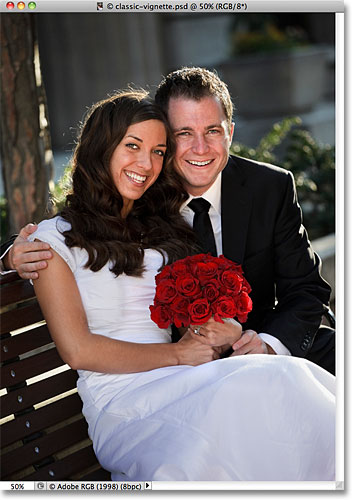
The original image.
Hither'south what the terminal result will await like:
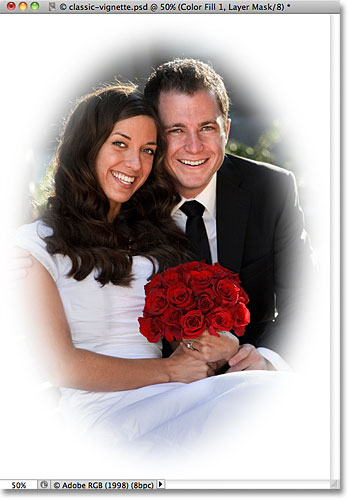
The final vignette result.
How To Create A Archetype Vignette Effect
Step i: Add A White Solid Color Fill up Layer
With the photo newly opened in Photoshop, we'll starting time by filling our document with white, which will become the color of the vignette edge. Ordinarily, we would but add a new bare layer to the document and and then apply Photoshop'due south Fill command to fill the new layer with white, but allow'due south do something different. Click on the New Fill or Adjustment Layer icon at the bottom of the Layers panel (it's the circle split diagonally betwixt black and white):
Click on the New Fill or Adjustment Layer icon.
This opens a list of all the fill and adjustment layers we tin cull from. Select a Solid Color make full layer from the height of the list:
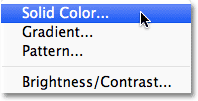
Cull Solid Color from the list.
As its name implies, a Solid Colour fill layer lets us quickly make full the document with a solid colour. As soon equally yous choose Solid Colour from the list, Photoshop pops open the Colour Picker so we can select the colour we want to use. Cull white, either past clicking in the height left corner of the large color selection box on the left or past entering 255 for the R, G and B values near the bottom center of the dialog box:
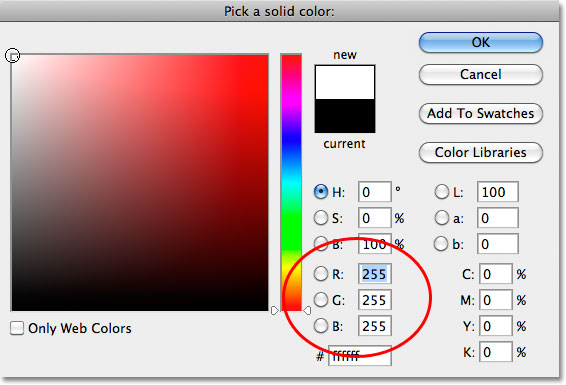
Choose white from the Color Picker.
Click OK to shut out of the Color Picker, and the certificate is now filled with solid white:

The Solid Colour fill layer fills the document with white.
Pace two: Select The Layer Mask
So why did we use a Solid Color fill layer here instead of but calculation a normal layer and filling it with white? The reason is considering the side by side thing we need to practice is add together a layer mask to the white-filled layer, just Photoshop's fill up layers, similar the Solid Color one we merely added, already come with a built-in layer mask so there's no demand for the states to add one ourselves! If we look in the Layers panel, nosotros meet the fill layer, which Photoshop named "Color Fill 1", sitting above the original image on the Background layer, and we see the layer mask thumbnail directly to the left of the layer's name. Click on the mask thumbnail to select it. A highlight edge will appear effectually the thumbnail letting you know the layer mask itself is at present selected:
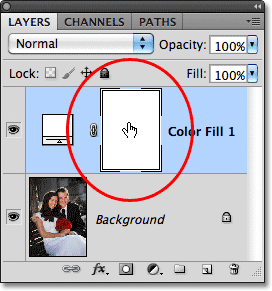
Fill up layers come with their ain layer masks. Click on the thumbnail to select the mask.
Footstep 3: Select The Elliptical Marquee Tool
Select the Elliptical Marquee Tool from the Tools panel. By default, it's hiding behind the Rectangular Marquee Tool, so click on the Rectangular Marquee Tool and concord your mouse button down for a second or ii until a fly-out menu appears showing the other tools available in that spot, then choose the Elliptical Marquee Tool from the listing:
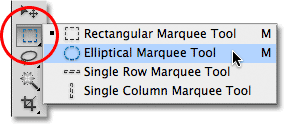
Click and concord on the Rectangular Marquee Tool, and then select the Elliptical Marquee Tool from the fly-out carte.
Stride 4: Drag Out An Elliptical Option Outline
With the Elliptical Marquee Tool selected, click within the certificate and drag out an elliptical selection outline in the eye of the certificate. Y'all can motion the selection outline effectually to reposition it as y'all're drawing it past holding down your spacebar and dragging it to a new location. Release your spacebar to go along dragging out the choice. Don't worry virtually its verbal size, shape or position for now because nosotros can easily fix things upwards after. All we demand at the moment is an initial elliptical selection outline:
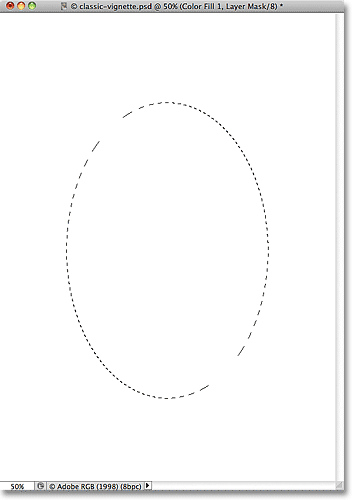
Drag out an initial elliptical selection outline. The exact size, shape and position isn't important.
Step 5: Fill up The Selection With Black
Become up to the Edit menu in the Carte du jour Bar along the tiptop of the screen and choose Fill:
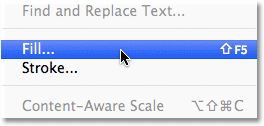
Go to Edit > Fill.
This opens the Fill dialog box. Change the Use option at the top of the dialog box to Blackness:
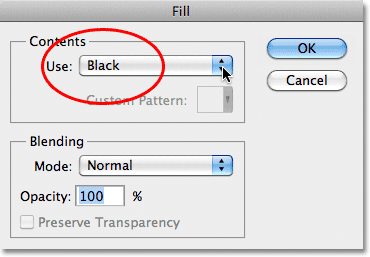
Modify the Use option to Black.
Click OK to close out of the Make full dialog box. Photoshop fills the choice with black, and because we had the layer mask selected on the Solid Color fill layer, the black effectively punches a hole through the fill layer, revealing the original photo on the Groundwork layer behind information technology:
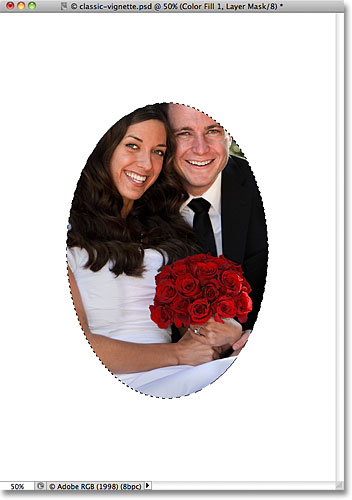
Filling the selection with black on the layer mask reveals the original photo underneath.
The layer mask thumbnail in the Layers panel shows usa the surface area we filled with black:
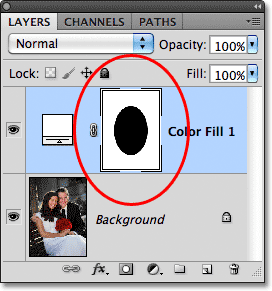
The layer mask thumbnail after filling the pick with black.
Step 6: Deselect The Option
We don't need our option outline anymore, so to remove it from the document, go up to the Select menu at the top of the screen and choose Deselect. Yous can also press Ctrl+D (Win) / Control+D (Mac) to quickly deselect it using the keyboard shortcut if you prefer:
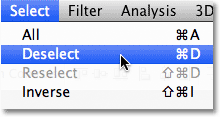
Go to Select > Deselect.
Stride 7: Use The Gaussian Blur Filter
To soften the edges of the vignette border, nosotros'll utilize Photoshop's Gaussian Blur filter. Become up to the Filter menu at the top of the screen, choose Blur, then choose Gaussian Mistiness:
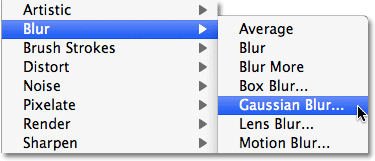
Go to Filter > Mistiness > Gaussian Mistiness.
This opens the Gaussian Mistiness dialog box. Keep an heart on your image every bit you brainstorm dragging the Radius slider at the bottom of the dialog box towards the right. The further to the right yous elevate the slider, the more blurring you'll employ to the vignette edges and the softer they'll go. The exact Radius value you cease up using volition depend on the size of the image you're working with. For me, a value of around 35 pixels works well, but your value may be different:
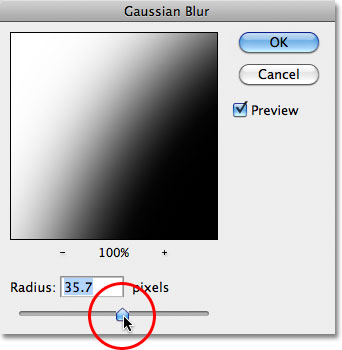
Soften the vignette edges by dragging the Radius slider towards the right.
Click OK when you're done to shut out of the dialog box. Your vignette edges should now appear softer:
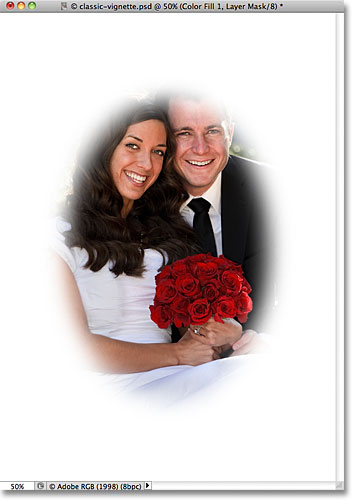
The image after softening the photo edge edges.
Step eight: Reshape And Motility The Border With Gratuitous Transform
With the photograph border edges at present softened, the only matter left to do is fine-tune information technology by resizing, reshaping and moving it as needed, and we can exercise all of that easily with Photoshop's Complimentary Transform command. Become upward to the Edit carte du jour at the tiptop of the screen and choose Free Transform. You lot can also press Ctrl+T (Win) / Command+T (Mac) to speedily access Free Transform with the keyboard shortcut:
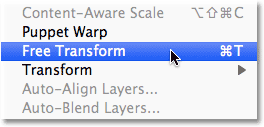
Go to Edit > Gratis Transform.
This places Photoshop's Costless Transform box and handles effectually the photo edge. To resize and reshape it, merely click on whatever of the handles (the little squares) and drag them. If y'all agree downward your Alt (Win) / Option (Mac) fundamental every bit you're dragging a handle, you'll resize the border from its middle rather than from the side or corner. To move the edge, simply click anywhere inside the bounding box and drag information technology around with your mouse. Continue dragging the handles and moving the border until you're happy with the manner information technology looks. When you're done, press Enter (Win) / Render (Mac) to accept the changes and exit out of the Costless Transform command:
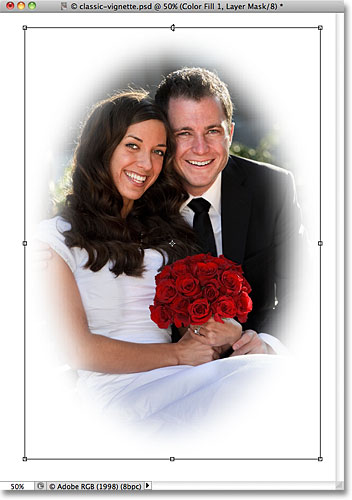
Use the handles to resize and reshape the vignette edges every bit needed. Click within the bounding box and drag with your mouse to reposition it.
Footstep nine: Trim Away Any Extra White Space
Finally, if y'all want to trim away any extra white space effectually the image, go up to the Paradigm menu at the top of the screen and choose Trim:
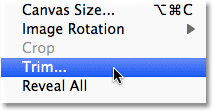
Go to Image > Trim.
This opens the Trim dialog box. Select the Height Left Pixel Color selection in the top half of the dialog box if it's not already selected, and exit the Top, Bottom, Left and Right options selected in the lesser one-half of the dialog box:
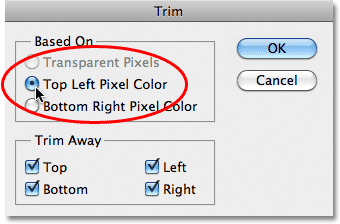
Select Pinnacle Left Pixel Color and leave the iv options at the bottom selected.
Click OK to shut out of the dialog box, and Photoshop trims away any actress white space around the epitome, leaving u.s. with our final vignette result:

The final result.
Other Stuff
© 2022 Photoshop Essentials.com.
For inspiration, non duplication.
Site design by Steve Patterson.
Photoshop is a trademark of Adobe Systems Inc.
How To Do Vignette In Photoshop,
Source: https://www.photoshopessentials.com/photo-effects/vignette/
Posted by: nestorcluall.blogspot.com


0 Response to "How To Do Vignette In Photoshop"
Post a Comment